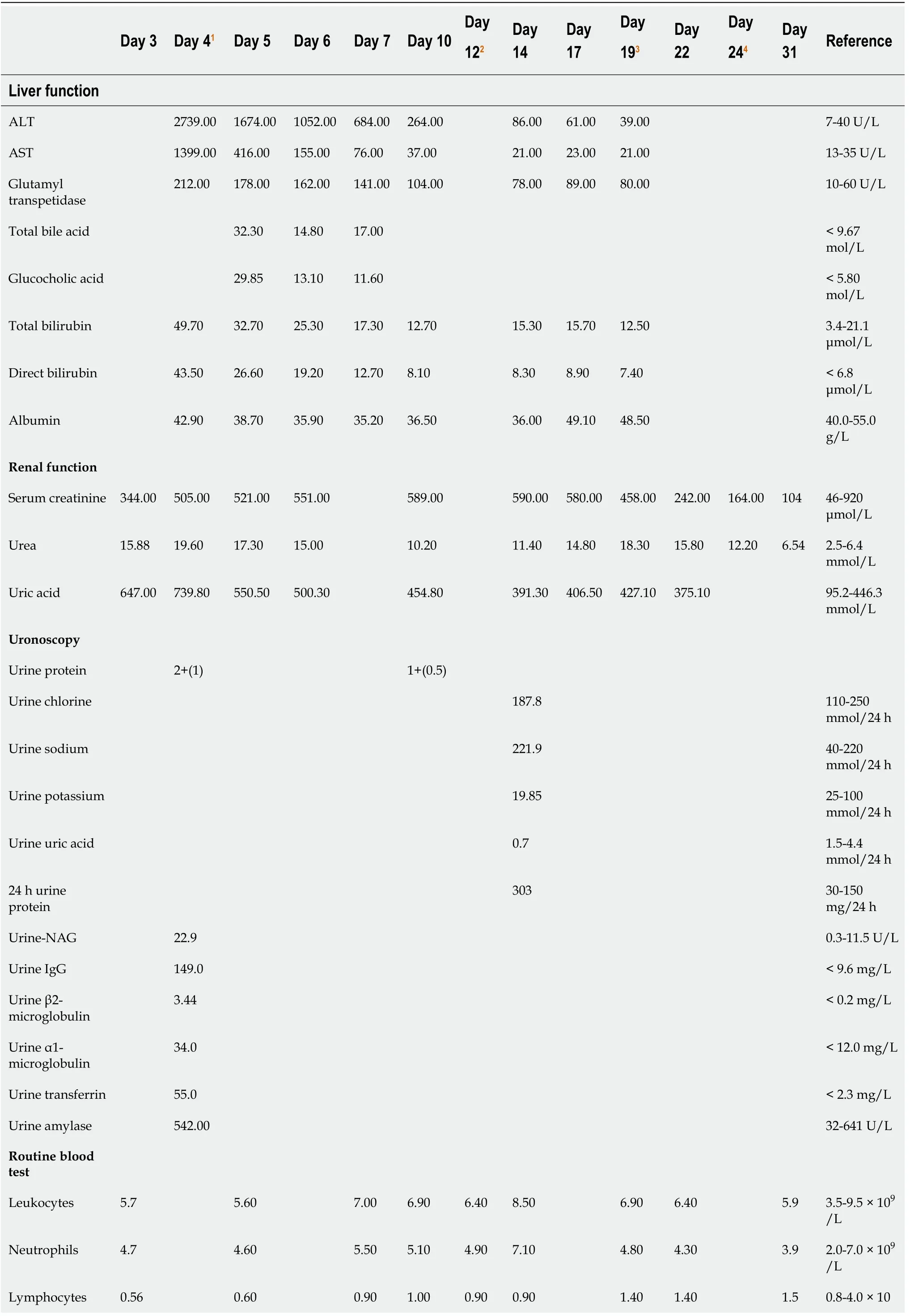Renal failure and hepatitis following ingestion of raw grass carp gallbladder:A case report
Li-Na Zhou,Shao-Shao Dong,Sheng-Ze Zhang,Department of Nephrology,Wenzhou People's Hospital,Wenzhou 325000,Zhejiang Province,China
Wen Huang,Department of Nephrology,The Second Affiliated Hospital of Wenzhou Medical University,Wenzhou 325000,Zhejiang Province,China
Abstract BACKGROUND Fish gallbladder has long been used as a folk remedy in Asian countries.Multiple organ damage after ingestion of fish gallbladder resulting in near mortality has been known to us.Here,we describe a case of acute renal failure (ARF) and hepatitis due to grass carp gallbladder poisoning and review the literature.CASE SUMMARY A previously healthy,50-year-old woman was admitted to our hospital with a 2-d history of generalized abdominal pain and repeated vomiting following ingestion of two raw grass carp gallbladders in an attempt to alleviate her cough.She developed anuria on day 4 with markedly elevated serum creatinine,urea,bilirubin,alanine aminotransferase,and aspartate aminotransferase.Based on thorough evaluation of her history and prompt biochemical investigations,we diagnosed her with ARF and hepatitis secondary to fish gallbladder poisoning.Her renal biopsy revealed acute tubular necrosis,following which she underwent six sessions of conventional hemodialysis due to renal failure.Supportive treatment with gastric mucosal protectant and liver protectant was administered for targeted organ protection.The patient’s liver function gradually recovered,and serum creatinine was 164 mmol/L at discharge on day 24.Over a follow-up period of 2 wk,her renal function completely recovered.CONCLUSION Physicians should be mindful of toxic complications of raw grass carp gallbladder ingestion and we should promote awareness to reduce incidences of food poisoning.
Key Words:Grass carp gallbladder;Case report;Acute renal failure;Hepatitis;Ichthyogallotoxin;Hemodialysis
INTRODUCTION
Fish gallbladder has long been used as a folk remedy in Asian countries.In some rural areas of southeastern and southern provinces in China,including Hong Kong and Taiwan[1],the habit of swallowing fish gallbladder to cure diseases such as asthma,arthritis,and cough;enhance visual acuity;and relieve pain is prevalent.Multiple organ damage after the ingestion of fish gallbladder nearly resulting in death has been known to occur.Cases of poisoning have also been reported in Cambodia,Japan,South Korea,India,and Vietnam[2-4].This practice poses a serious health concern from the standpoint of food safety.With improved developments in healthcare in China,we now have an effective treatment for patients with fish gallbladder poisoning.The purpose of this report is to raise awareness regarding food poisoning that may arise secondary to the ingestion of raw cyprinid fish.
CASE PRESENTATION
Chief complaints
A previously healthy,50-year-old woman was admitted to our hospital with a 2-d history of generalized abdominal pain and repeated vomiting following ingestion of two raw grass carp gallbladders.
History of present illness
The patient consumed two raw grass carp gallbladders (approximately 4-6 mL) for alleviation of her cough 2 d prior to presenting at our hospital.She developed diffuse abdominal pain and profuse vomiting 6 h after its ingestion,accompanied by sweating,dry mouth,heaviness in the chest,and dizziness.
History of past illness
She had no history of hypertension,diabetes,cardiac disease,cerebrovascular disease,allergies,or surgical interventions.
Personal and family history
She had no relevant family history.
Physical examination
At admission,her temperature was 37.1 °C,pulse rate 46/min,respiratory rate 20/min,and blood pressure 108/74 mmHg.She had upper abdominal tenderness,with no rebound pain,hyperactive bowel sounds of 5-6/min,and no pain on renal percussion.The rest of her systemic examination was unremarkable.
Laboratory examinations
At admission,her serum creatinine was 344 μmol/L and urea was 15.88 mmol/L(normal range being 2.5-6.4 mmol/L).On day 4,her urine output decreased drastically(<100 mL over 24 h).Serum creatinine markedly rose to 505 μmol/L.Liver function tests revealed increased alanine aminotransferase,aspartate aminotransferase,total bilirubin,and direct bilirubin,as shown in Table 1.
Imaging examinations
Her echocardiogram (ECG) revealed sinus bradycardia of new onset,with a heart rate(HR) of 46/min at that time.
FINAL DIAGNOSIS
The patient was diagnosed with acute renal failure (ARF) and hepatitis.
TREATMENT
The patient was started on 3-4 h sessions of hemodialysis on day 4 due to renal failure,which was then maintained every 2 d.Gastric mucosal protectant omeprazole 40 mg iv daily for 4 d and reduced glutathione 1.2 g iv daily for 14 d were administered.
OUTCOME AND FOLLOW-UP
The patient’s urine output increased to 1400 mL/24 h on day 12,liver function improved,and dialysis was withdrawn on day 19.After the exclusion of contraindications,she consented to undergo renal biopsy to identify the cause of her ARF on day 13;the biopsy revealed acute tubular necrosis.She was discharged on day 24,with serum creatinine level having decreased to 164 μmol/L.After discharge,she was followed with weekly serum biochemical tests at the nephrology outpatient department and her renal function recovered completely after 2 wk.
Repeat ECG revealed persistence of sinus bradycardia (HR 52 bpm).Test results are shown in Table 1.Cardiac ultrasound and pulmonary and abdominal computed tomography findings were normal.
DISCUSSION
Wuet al[2]have reviewed fish with poisonous gallbladders in China.There are currently 12 known species of fish with poisonous bile in China,all of which belong to the freshwater fish family Cyprinidae.Poisoning caused by grass carp gallbladder accounts for >80% of all cases because the grass carp has a relatively big gallbladder.
Ichthyogallotoxin has been studied extensively in grass carp bile[5].The compound 5α-cyprinol sulfate (5α-cholestane-3α,7α,12α,26,27-pentol-26-sulfate) has the molecular formula C27H48O8S.Mohriet al[6]reported that essentially all bile toxicity could be explained by the properties of cyprinol sulfate,based on the LD50values.Toxicity is dose-dependent,depending on the quantity of bile and size of the ingested fish gallbladder[7].
After the ingestion of fish gallbladder,damage to multiple organs,such as the gastrointestinal,renal,hepatic,cardiac,and neurological systems,has been reported previously[8].The initial symptoms[8]were similar to those of gastroenteritis,occurring 0.5-4 h after the consumption of the offending agent.Edema,oliguria,or anuria may occur within 2-3 d after poisoning,sometimes even as late as 3-6 d,as reported previously[8].A remarkable increase in urea,serum creatinine,and urine N-acetyl-beta-D-glucosaminidase (NAG) with non-glomerular proteinuria was observed in our patient.ARF caused by the ingestion of fish gallbladder has been reported in several case series[9,10],with a morbidity rate of 55%-100% and overall mortality rate of 91.7% in all gallbladder consumers.Although some reports have shown improvement of renal function within 2-3 wk[11],the recovery time was 5 wk in our patient.Elevation of liver enzymes or jaundice occurs in 75%-87% of patients[9].Liver and kidney damages often occur simultaneously[12],and mild hepatitis caused by carp gallbladder is usually self-limited.Our patient’s liver function recovered on day 19,which was consistent with the findings of previous reports.These patients can also die of fulminant hepatic failure[3].Other manifestations include cardiac complications (palpitations,hypertension,and myocardial damage) and neurological involvement (convulsion and coma),which vary individually.

Table 1 Selected indicators after admission

9/L Hemoglobin 125 116.00 114.00 105.00 93.00 92.00 89.00 91.00 83 115-150 g/L Platelets 156 128.00 116.00 122.00 98.00 84.00 111.00 156.00 161 125-350 × 10 9/L Inflammatory indicators C-reactive protein 1.4 12.90 6.10<10.0 mg/L Procalcitionin 3.31 0.12<0.50 ng/mL Serum amyloid A 89.60 7.60 0-10 mg/L Erythrocyte sedimentation rate 9<20 mm/h Coagulation function Prothrombin time 12.40 11.20 11.50 9.5-14.1 s Activated partial thromboplastin time 25.50 27.70 25.1-36.5 s Thrombin time 17.20 14.60 11.8-17.8 s D-dimer 7.20 1.69 4.84<0.50 mg/L Blood gas analysis PH 7.35 7.35-7.45 PaCO2 29.4 35.0-48.0 mmHg PaO2 81.9 80.0-100.0 mmHg Actual bicarbonate radical 16 22-27 mmol/L Standard bicarbonate radical 18 21-25 mmol/L Electrolytes K+4.60 4.40 4.20 3.80 3.80 3.50 3.40 3.80 3.80 4.00 4.00 3.5-5.3 mmol/L Na+138.00 133.00 135.00 137.00 137.00 137.00 136.00 137.00 139.00 136.00 138.00 137-147 mmol/L Cl-103.00 100.00 99.00 99.00 101.00 99.00 95.00 90.00 95.00 94.00 98.00 99-110 mmol/L P 1.50 1.34 1.64 1.65 1.30 1.22 2.04 1.64 0.83-1.48 mmol/L Ca2+2.29 2.22 2.18 2.21 2.10 2.17 2.10 2.31 2.49 2.15-2.5 mmol/L Other indicators Serum ferritin 770.7 11.0-306.8 ng/mL Transferrin saturation 18 15%-45%Folic acid 11.4 3.1-20.5 ug/L

1Day 4:Convention hemodialysis was performed.2Day 12:Patient’s urine output increased to 1400 mL.3Day 19:Liver function improved and dialysis was withdrawn.4Day 24:The patient was discharged with serum creatinine at 164 μmol/L.IgG:Immunoglobulin G;HAV:Hepatitis A virus;HBV:Hepatitis B virus;HCV:Hepatitis C virus;HEV:Hepatitis E virus;ANA:Antinuclear antibodies;anti-GBM:Anti-glomerular basement membrane antibody;ANCA:Antineutrophil cytoplasmic antibodies;IgE:Immunoglobulin E;IgA:Immunoglobulin A;IgM:Immunoglobulin M;ALT:Alanine aminotransferase;AST:Aspartate aminotransferase;NAG:N-acetyl-beta-D-glucosaminidase;TORCH:Toxoplasma gondii,other,rubella virus,cytomegalovirus and herpes simplex virus.
The exact mechanisms of the toxic effects are not clear.However,necrosis of the renal proximal tubules (PT) may play an important role in the development of ARF[13].The pathological severity correlated with clinical symptoms of sudden oliguria or anuria as well as increased urine NAG,a marker of tubular injury[14].In an animal study[13],glomerular filtration rate decreased 24 h after the ingestion of 0.3 mL of grass carp bile,suggesting that nephrotoxic substances cause cellular damages by inhibiting the cytochrome oxidase,promoting calcium influx,and inducing lysosome membrane instability[9].In a porcine study,Choiet al[15]suggested that nitric oxide generation and the phospholipase C pathway affect the release of renal dipeptidase from the PT,which may be involved in the development of ARFin vivoafter the ingestion of carp bile.The significance of interstitial edema and inflammation characterized by infiltration of lymphocytes and monocytes observed on renal biopsy can be explained by the serious inflammatory response to cell necrosis induced by increased cell membrane permeability and the resultant enzyme release.In addition to renal toxicity,fish bile may cause a series of inflammatory responses evidenced by increased inflammatory mediators and cytokines,eventually leading to pathological changes of cell degeneration and necrosis.Another study[16]showed that plasma endothelin levels correlated with the severity of carp gallbladder poisoning.In our patient,C-reactive protein,procalcitionin,and serum amyloid A levels were increased.However,the role of inflammation in carp gallbladder toxicity requires further elucidation.
Moreover,in our patient,we found decreased leukocytes,neutrophils,lymphocytes,hemoglobin,and platelets and sinus bradycardia in the ECG,which,to our knowledge,have not been previously reported.In 1993,Limet al[17]reported a case of sinus bradycardia that persisted for 2 d even after atropine was administered for symptomatic relief.A previous study has demonstrated experimentally that bile acids can affect the cardiovascular functions of animals bothin vivoandin vitro,inducing bradycardia and systemic hypotension[18].Further,it was found that the bile salts cause potent hemolysisin vitro[18].In our patient,decreased counts of leukocytes,neutrophils,lymphocytes,and platelets resolved spontaneously,although anemia lasted for >3 wk.Sinus bradycardia persisted for 2 d.We hypothesized that there may be an undiscovered hematotoxin or cardiotoxin in fish gallbladder,which needs further investigations.
There is no specific antidote for carp gallbladder poisoning.However,gastric lavage using 1%-5% soda or warm water is necessary in the first 72 h.Protecting the gastric mucosa by administering raw eggs or cattle milk may be effective[11].Conventional hemodialysis is an effective temporary treatment for anuria or oliguria.Liuet al[19]revealed that continuous venovenous hemodiafiltration could effectively remove inflammatory mediators,metabolites,bilirubin,and toxins in severe cases while maintaining homeostasis.Our patient did not receive gastric lavage with 1%-5% soda or warm water due to the earlier misdiagnosis of gastroenteritis and delayed presentation at our center after poisoning.Supportive treatments,including gastric mucosal protectant and liver protectant,were provided appropriately and were tolerated in our patient,which aided her clinical recovery.
CONCLUSION
In summary,the diagnosis of this disease is primarily clinical and dependent on the history,as there are no special laboratory tests to confirm the disease.General practitioners,emergency physicians,and gastroenterologists should be mindful of the toxic complications of raw grass carp gallbladder.Educating the public regarding the toxic effects of raw gallbladder injection could be helpful in reducing the incidence of its toxicity,especially in the rural areas.
ACKNOWLEDGEMENTS
This case report was supported by ward doctors,especially in collection of specimens,treatment,analysis,and interpretation of data.We also extend our gratitude to the patient for providing the necessary medical history information,and to Dr.Huang for assistance in editing the final manuscript.
 World Journal of Clinical Cases2021年4期
World Journal of Clinical Cases2021年4期
- World Journal of Clinical Cases的其它文章
- Isolated interrupted aortic arch in an adult:A case report
- Fertility-sparing surgeries without adjuvant therapy through term pregnancies in a patient with low-grade endometrial stromal sarcoma:A case report
- Primary nonkeratinizing squamous cell carcinoma of the scapular bone:A case report
- Acute inferior wall myocardial infarction induced by aortic dissection in a young adult with Marfan syndrome:A case report
- Immediate implant placement in combination with platelet rich-fibrin into extraction sites with periapical infection in the esthetic zone:A case report and review of literature
- Pheochromocytoma as a cause of repeated acute myocardial infarctions,heart failure,and transient erythrocytosis:A case report and review of the literature
